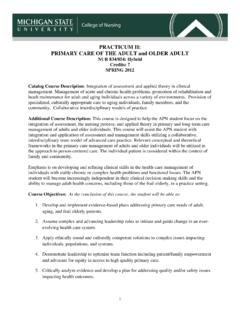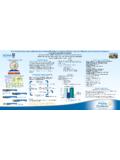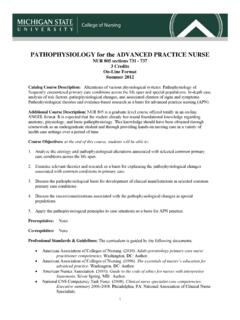Transcription of Eliminating Scope of Practice Barriers for Illinois ...
1 Eliminating Scope of Practice Barriers for Illinois advanced Practice Nurses Expanding the pool of healthcare providers to meet the increasing demand for quality, safe and cost effective health services in Illinois . January 2013 1 Background ..2 Defining advanced Practice Nurses (APNs) ..2 advanced Practice Nursing Specialties ..3 Why Expand the APN Role in Illinois Now? ..4 Changing Demographics ..4 Health Status Indicators in Illinois ..5 Shortage of Primary Care Physicians ..6 Health Reform ..7 National Trends ..8 Quality and Cost Effectiveness ..9 Recommended Policy Changes ..10 Conclusion ..10 Works Cited ..10 Report developed by Alexandra Luterek and Margie Schaps Health and Medicine Policy Research Group 29 E.
2 Madison Suite 602 Chicago, Illinois 60602-4404 p: (312) f: (312) 2 Illinois faces an opportune moment to consider the role of nursing in primary care. Changing demographics, opportunities provided by national and state health reform, and the rising costs of healthcare affect how high quality, cost effective care will be provided moving forward. Nursing represents the largest sector of health professions, and therefore, the role of nurses should be addressed in this time of social, economic, and political change. advanced Practice nurses (APNs) may fulfill new roles in the redesigned health system, provided that the law allows them to Practice to the full extent of their education and training. Eliminating the requirement for a collaborative agreement between APNs and physicians is a viable mechanism for increasing primary care capacity and reducing health care costs.
3 Under a reformed Scope of Practice , public and private insurers could choose to reimburse APNs directly for their services, as opposed to reimbursing them as a part of clinics or physician practices . It would also allow consumers to choose a non-physician health professional as their primary care provider. It is in the interest of the state of Illinois and the greater healthcare community to allow advanced Practice nurses to provide unrestricted, safe, quality health care services to the residents of Illinois . APNs include nurse practitioners (NPs), certified nurse midwives (CNMs), certified registered nurse anesthetists (CRNAs), and clinical nurse specialists (CNSs). The education and training of APNs includes health promotion, disease prevention, diagnosis, and treatment.
4 APNs integrate a wide range of skill sets in collaborating with members of various disciplines, such as medicine, social work, nutrition, and physical therapy. In states where APNs act as independent practitioners, they alleviate primary care service shortages and promote public health by providing preventive health counseling and chronic disease management. The National Council of States Boards of Nursing (NCSBN) defines APN preparation as having: 1. Completed accredited graduate-level education program 2. Passed a national certification examination 3. advanced clinical knowledge and skills for direct patient care 4. Education that prepares him/her with the responsibility and accountability to promote healthy lifestyles and to assess, diagnose, manage patient problems, including the use and prescription of pharmacologic and non-pharmacologic therapies.
5 5. Demonstrated proficiency in analysis of data, role autonomy, demonstrates greater depth and breadth of knowledge with registered nursing competency as the foundation (NCSBN, 2012). Nurses are poised to help bridge the gap between coverage and access, to coordinate increasingly complex care for a wide range of patients, to fulfill their potential as primary care providers to the full extent of their education and training, and to enable the full economic value of their contributions across Practice settings to be realized - Institute of Medicine Future of Nursing Report (2011) 3 advanced Practice Nursing Specialties Who Are They Number in US Number in IL What do they do? Where do they Practice ? Certified Nurse Practitioner (NP) 158,348 5,057 Take health histories and provide complete physical exams; diagnose and treat acute and chronic illnesses; prescribe and manage medications; order and interpret lab tests and X-rays; provide health teaching and supportive counseling, and refer to other health professionals as needed Across healthcare settings, in areas of Acute Care, Adult Health, Family Health, Geriatrics, Neonatal, Pediatric, Psychiatric/Mental Health, School Health, and Women s Health.
6 Certified Clinical Nurse Specialist (CNS) 59,242 1,014 Provide advanced nursing care in hospitals and other clinical sites; provide acute and chronic care management; develop quality improvement programs; serve as mentors, educators, researchers, and consultants. According to a 2010 NACNS survey, approximately 70% of CNSs work in some type of inpatient hospital setting. The remainder works in clinical locations that range from home health care, long term care/nursing homes, public health centers and ambulatory care. Certified Registered Nurse Anesthetist (CRNA) 34,821 1,715 Administer anesthesia and related care before and after surgical, therapeutic, diagnostic and obstetrical procedures, as well as pain management and emergency services, such as airway management Operating rooms, dental offices and outpatient surgical centers.
7 CRNAs deliver more than 65% of all anesthetics to patients in the United States. CRNAs are the primary providers of anesthesia care in rural areas, enabling healthcare facilities in these medically underserved areas to offer obstetrical, surgical, pain management and trauma stabilization services. (IANA, 2011) Certified Nurse Midwive (CNM) 18,492 413 Provide primary care to women, including gynecological exams, contraceptives, prenatal care, management of low-risk labor and delivery, and neonatal care. Hospitals, birthing centers, community clinics and patient homes. There are currently 221 nurse-midwifery practices located throughout the state. In 2007, CNMs in Illinois attended 10,746 births, which is approximately of all births in that state for 2007.
8 (ACNM, 2007) (IOM Future of Nursing Report, 2011) ( Illinois Department of Financial and Professional Regulation) 4 Why Expand the APN Role in Illinois Now? Changing Demographics Aging Population: The proportion of the population aged 65 or older is expected to rise from % in 2008 to % in 2030 ( Census Bureau, 2008), in part as a result of increases in life expectancy and the aging of the Baby Boom generation. The demand for long term care services provided by APNs is expected to grow. o About 26% of the Illinois population is aged 65 and older (Kaiser State Health Facts, 2010-2011). o The Illinois population aged 65 and older was in 2000; it is projected to become 18% by 2030 ( Illinois Office of the Comptroller, 2008) o In 2008, billion Illinois Medicaid dollars went toward long-term care services involving the elderly (Kaiser Family Foundation, as cited by the Illinois Office of the Comptroller) Prevalence of Chronic Diseases: Most health care today relates to chronic conditions, such as diabetes, hypertension, arthritis, cardiovascular disease, and mental health conditions.
9 In 2005, these conditions affected nearly one of every two Americans (CDC, 2010). Preventing chronic diseases lowers health care costs, hospital admissions, and encourages productivity of the workforce. The APN training focus on prevention makes them ideal to address chronic disease prevention. Increasingly Diverse Population: Minority groups, which currently make up about a third of the population, are projected to become 54 percent of the total population by 2050 ( Census Bureau, 2008). To be effective, information must be accessible and offered in a manner that is understandable and culturally relevant (IOM, 2004; Joint Commission, 2007). According to the most recent National Sample Survey of Registered Nurses, published by the Health Resources and Services Administration, Bureau of Health Professions, Division of Nursing, approximately 11% of nurse practitioners are nurses of color, and that figure is expected to increase.
10 Health Disparities: Health disparities are inequities in the burden of disease, injury, or death experienced by socially disadvantaged groups relative to either whites or the general population. Such groups may be categorized by race, ethnicity, gender, sexual orientation, and/or income. Health disparities among these groups are driven in part by deleterious socio-environmental conditions and behavioral risk factors, and in part by systematic biases that often result in unequal, inferior treatment (IOM, 2003). APNs provide services in areas facing high rates of health disparities, such as in densely populated urban areas, or rural areas lacking adequate health resources. o Illinois is among those states with the highest rates of death due to colorectal cancer (ranked 48th ); the state s black population has higher rates than the white population, while the Hispanic population rates are notably lower.









